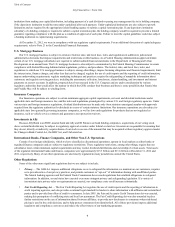Ally Bank 2012 Annual Report Download - page 21
Download and view the complete annual report
Please find page 21 of the 2012 Ally Bank annual report below. You can navigate through the pages in the report by either clicking on the pages listed below, or by using the keyword search tool below to find specific information within the annual report.19
expensive for us to conduct our business. For example, business and economic conditions that negatively affect household incomes, housing
prices, and consumer behavior related to our businesses could decrease (1) the demand for our new and used vehicle financing and (2) the
value of the collateral underlying our portfolio of held-for-investment assets and new and used vehicle loans and interests that continue to be
held by us, thus further increasing the number of consumers who become delinquent or default on their loans. In addition, the rate of
delinquencies, foreclosures, and losses on our loans could be higher during more severe economic slowdowns.
Any sustained period of increased delinquencies, foreclosures, or losses could further harm our ability to sell our new and used vehicle
loans, the prices we receive for our new and used vehicle loans, or the value of our portfolio of mortgage and new and used vehicle loans
held-for-investment or interests from our securitizations, which could harm our revenues, profitability, and financial condition. Continued
adverse business and economic conditions could affect demand for new and used vehicles, housing, the cost of construction, and other related
factors that could harm the revenues and profitability of our business.
The current debt crisis in Europe, the risk that certain countries may default on their sovereign debt, and recent rating agency actions
with respect to European countries and the United States and the resulting impact on the financial markets, could have a material adverse
impact on our business, results of operations and financial position.
The current crisis in Europe has created uncertainty with respect to the ability of certain European Union countries to continue to service
their sovereign debt obligations. In the past several years, rating agencies have lowered their ratings on several euro-zone countries. The
continuation of the European debt crisis has adversely impacted financial markets and has created substantial volatility and uncertainty, and
will likely continue to do so. Risks related to this have had, and are likely to continue to have, a negative impact on global economic activity
and the financial markets. The effects of the European debt crisis could be even more significant if a Eurozone country determines to depart
the European Monetary Union, which would lead to redenomination of obligations of obligors in that country and cause foreign exchange,
operational, and settlement disruptions. In addition, on August 5, 2011, Standard & Poor’s Ratings Services lowered its long-term sovereign
credit rating on the United States of America to ‘AA+’ from ‘AAA’, and the outlook on its long-term rating is negative. The U.S. downgrade,
any future downgrades, as well as the perceived creditworthiness of U.S. government-related obligations, including uncertainty surrounding
the U.S. federal deficit and debt ceiling debate, could impact our ability to obtain, and the pricing with respect to, funding that is collateralized
by affected instruments and obtained through the secured and unsecured markets. As these conditions persist, our business, results of
operation, and financial position could be materially adversely affected.
Acts or threats of terrorism and political or military actions taken by the United States or other governments could adversely affect
general economic or industry conditions.
Geopolitical conditions may affect our earnings. Acts or threats of terrorism and political or military actions taken by the United States or
other governments in response to terrorism, or similar activity, could adversely affect general economic or industry conditions.
The U.S. Department of Treasury (Treasury) holds a majority of the outstanding common stock.
At February 28, 2013, Treasury held 981,971 shares of common stock, which represents approximately 74% of the voting power of the
holders of common stock outstanding for matters requiring a vote of the holders of common stock. In addition, as of the date hereof, Treasury
holds 118,750,000 shares of Series F-2 Preferred Stock (which are convertible into shares of common stock in accordance with Ally's
certificate of incorporation), with an aggregate liquidation preference of approximately $5.9 billion.
Pursuant to the Amended and Restated Governance Agreement dated May 21, 2009, as of the date hereof, Treasury also has the right to
appoint six of the eleven members to our board of directors. As a result of this stock ownership interest and Treasury's right to appoint six
directors to our board of directors, Treasury has the ability to exert control, through its power to vote for the election of our directors, over
various matters. To the extent Treasury elects to exert such control over us, its interests (as a government entity) may differ from those of our
other stockholders and it may influence, through its ability to vote for the election of our directors, matters including:
• the selection, tenure and compensation of our management;
• our business strategy and product offerings;
• our relationship with our employees and other constituencies; and
• our financing activities, including the issuance of debt and equity securities.
In particular, Treasury may have a greater interest in promoting U.S. economic growth and jobs than our other stockholders. In the future
we may also become subject to new and additional laws and government regulations regarding various aspects of our business as a result of
participation in the TARP program and the U.S. government's ownership in our business. These regulations and actions by directors could
make it more difficult for us to compete with other companies that are not subject to similar regulations.
Table of Contents
Ally Financial Inc. • Form 10-K
























